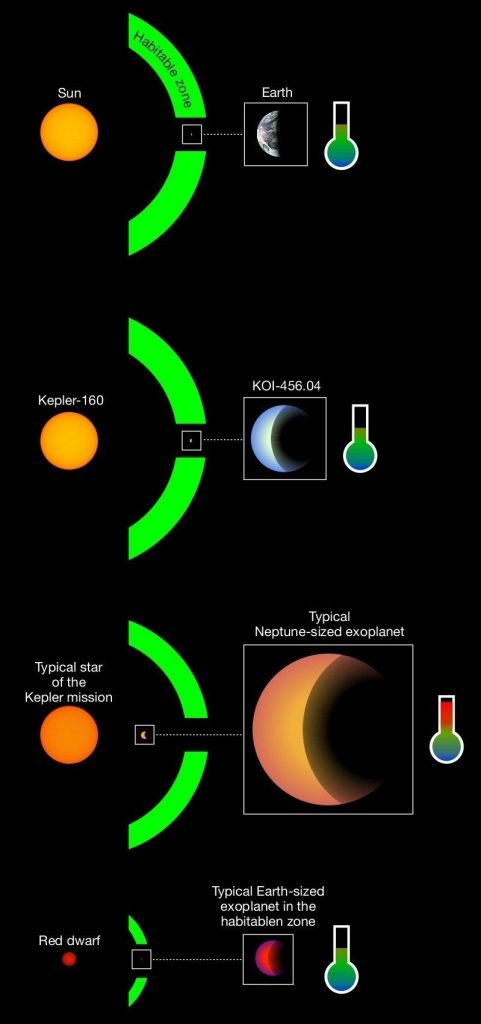Among the more than 4,000 known exoplanets, KOI-456.04 is something special: less than twice the size of Earth, it orbits a Sun-like star. And it does so with a star-planet distance that could permit planetary surface temperatures conducive to life.
The object was discovered by a team led by the Max Planck Institute for Solar System Research in Göttingen. Its host star, called Kepler-160, actually emits visible light; the central stars of almost all other exoplanets, on the other hand, emit infrared radiation, are smaller and fainter than the Sun and therefore belong to the class of red dwarf stars.
Space telescopes such as CoRoT, Kepler, and TESS have allowed scientists the discovery of about 4000 extrasolar planets (planets around distant stars) within the past 14 years. Most of these planets are the size of the gas giant planet Neptune, about four times the size of the Earth, and in relatively close orbits around their respective host stars. But scientists have also discovered some exoplanets as small as the Earth that could potentially be rocky. And a handful of these small planets are also at the right distance to their host star to potentially have moderate surface temperatures for the presence of liquid surface water – the essential ingredient for life on Earth.

“The full picture of habitability, however, involves a look at the qualities of the star too,” explains MPS scientist and lead author of the new study Dr. René Heller. So far, almost all exoplanets less than twice the size of Earth that have a potential for clement surface temperatures are in orbit around a red dwarf.
Red dwarf stars are known for their extremely long lifetimes. Life on an exoplanet in orbit around an old red dwarf star could potentially have had twice as much time than life on Earth to form and evolve. But the radiation from a red dwarf star is mostly infrared rather than visible light as we know it. Many red dwarfs are also notorious for emitting high-energy flares and for frying their planets, which would later become habitable, with enhanced stellar luminosities as long as these stars are young. Moreover, their faintness requires any habitable planet to be so close to the star that the stellar gravity starts to deform the planet substantially. The resulting tidal heating in the planet could trigger fatal global volcanism. All things combined, the habitability of planets around red dwarf stars is heavily debated in the scientific community.
In their new research article, the team of scientists from MPS, the Sonneberg Observatory, the University of Göttingen, the University of California in Santa Cruz, and from NASA now reports the discovery of a planet candidate less than twice the size of the Earth and with moderate illumination from a Sun-like star
At a distance of just over 3000 light-years from the solar system, the star Kepler-160 was located in the field of view of the Kepler primary mission and was continuously observed from 2009 to 2013. Its radius of 1.1 solar radii, its surface temperature of 5200 degrees Celsius (300 degrees less than the Sun), and its very Sun-like stellar luminosity make it an astrophysical portrayal of our own parent star.
Kepler-160 has been known for about six years to be a host star of two exoplanets, called Kepler-160b and Kepler-160c. Both of these planets are substantially bigger than Earth and in relatively close orbits around their star. Their surface temperatures would certainly make them hotter than a baking oven and everything but hospitable for life as we know it. But tiny variations in the orbital period of planet Kepler-160c gave scientists a signature of a third planet that had yet to be confirmed.
The team of German and US American scientists now returned to the archival Kepler data of Kepler-160 to search for additional planets around that star and to verify the planetary origin of the perturber of the orbit of Kepler-160c. Heller and his colleagues had previously been successful in finding a total of 18 exoplanets in old Kepler data.
When searching for exoplanets, scientists usually look for repeating brightness variations of stars. These temporary dimmings, usually just one percent or less of the apparent stellar brightness, can be caused by planets transiting the disks of their host stars as seen from Earth. The key idea of Michael Hippke, co-author of the new work, and Heller was to use a detailed physical model of the stellar brightness variation instead of searching for a step-like jump-to-dimming and then jump-back-to-normal brightness pattern in stellar light curves.